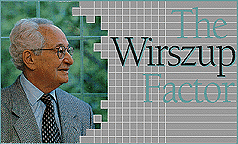
The University of Chicago Magazine
October-December 1996

Continued
the professor emeritus remembers. "He looked so cold."
Wirszup and his wife, Pera, then a University instructor in conversational Russian, quickly invited McHenry to dinner. "He spoke such wonderful Russian," Wirszup says, his own English accented here and there by detectable traces of Polish, Yiddish, German, and French, as well as Russian. "Pera enjoyed talking with him."
The relationship didn't end with dinner. "Izaak received bagfuls of these Soviet books," says McHenry, who now teaches at Georgetown University's business school. "He was shipped two copies of each, so he always had one for me to read. But in addition to allowing me to look at the books, he would talk to me and give me encouragement as a young scholar. He has a generous spirit that I really admire."
About two years after McHenry began his semiannual visits to Chicago and Wirszup, the dismayed mathematics professor disclosed that his NSF funding was about to run out, and a general cutback in government funding meant it wouldn't be renewed. Wirszup's young friend mentioned someone who might be able to help: his father, Keith McHenry (now deceased), who was then Amoco Oil Company's vice- president of research and development.
A few weeks later, the elder McHenry and Wirszup met. Keith McHenry was so impressed by what he heard that he decided to do something not just about the textbook project, but about the larger problem that had so long worried Wirszup--the disparity between the quality of Soviet and U.S. mathematics education. As a result of McHenry's urging, Amoco eventually provided more than $8 million to fund what became, with the help of Wirszup and a cast of hundreds, the University of Chicago School Mathematics Project (see "Large Numbers on Campus," page 36).
Though they haven't yet achieved the broad-based use of the New Math curriculum introduced in U.S. schools during the 1960s, UCSMP secondary-school texts now are used by about 15 percent of the nation's students in junior high and above. The UCSMP texts are written in a pragmatic rather than abstract style, to appeal to the broad middle range of American students. As a result, "average" students are learning more difficult mathematics sooner than they otherwise would.
"What Izaak pointed out was that students in the Soviet Union, as well as in Japan and elsewhere, begin learning algebra at age 12, while in the United States, the average age was 14," explains Zalman Usiskin, professor of education at the University and current director of UCSMP. The UCSMP materials, reflecting Wirszup's argument that U.S. schools should learn from these successes, incorporates geometry and algebra into the curriculum much earlier than had been the American tradition.
Since the project began, mathematics scores on standardized tests for entering college students nationwide have been rising: from a 1984 median SAT mathematics score of 494 to a 1996 median score of 508. While some of that increase may be directly due to the use of UCSMP curricula, much of it is also thanks to Izaak Wirszup's personal crusade for better mathematics education--a crusade that's included appearances before several congressional committees, as well as speeches and interviews across the country.
An emeritus professor since 1985, Wirszup directs the UCSMP's resource-development component and continues to
oversee translations of international mathematics materials for the project. The texts he began collecting so many years ago now form the International Mathematics Education Resource Center, attracting educators from around the world. Earlier this year, the National Council of Teachers of Mathematics (NCTM) recognized his contributions, awarding Wirszup its lifetime-
achievement medal. "We need only look at Izaak," said NCTM president Jack Price in presenting the award, "at his determination, commitment, and unfaltering belief that 'you can do it' to see a successful teacher who has made a difference."
Continue reading "The Wirszup Factor"
Sidebar: "Large Numbers on Campus," about the U of C School Mathematics Project
Go to:
- INVESTIGATIONS
- CHICAGO JOURNAL
- EVENTS
- LETTERS
- CHICAGOPHILE
- Feature story, "The Strange Laboratory of Dr. LaBarbera"
- Feature story, "Strength in Numbers"
- Special Report, "Building a Strong Cornerstone"
- Feature story, "The Wirszup Factor"
- CLASS NEWS
- DEATHS
- BOOKS BY ALUMNI
- IN THE CLUBS
Return to October-December 1996 Table of Contents